The Microsoft Surface Studio Review
by Brett Howse on January 20, 2017 8:00 AM EST- Posted in
- Desktop
- Microsoft
- Surface
- Surface Studio
System Performance
As is typical with an all-in-one PC, the Surface Studio uses mobile parts to ensure things don’t get too toasty. The base model ships with a Core i5-6440HQ, which is a quad-core processor running at 2.6-3.5 GHz. There is 6 MB of cache and no hyperthreading, and it has a 45-Watt TDP. The CPU is likely fine for most tasks, but the base Surface Studio comes with just 8 GB of DDR4 memory, which would hardly be called adequate for an almost $3000 computer. Graphics to run the 13.5 million pixel display come courtesy of the NVIDIA GeForce GTX 965M, launched at CES in 2015.
The jump up to the mid-level model offers a lot more computer, but comes at a cost of an additional $500. The CPU is upgraded to the Core i7-6820HQ, which is a quad-core with hyperthreading, and a 2.7-3.6 GHz frequency, along with 8 MB of cache. The big upgrade is the RAM, which doubles to a more respectable 16 GB, and while the GPU is the same, and the hard drive capacity is the same, the mid-level model doubles the SSD cache from a 64 GB SATA SSD to a 128 GB PCIe SSD. While the CPU is going to offer more performance, especially in heavily-threaded workloads, the increased RAM and SSD cache are likely to do more for the overall performance than anything, and the mid-level is really where the Surface Studio should have started.
Our review unit is the top level model, with the same Core i7-6820HQ CPU as the mid-level model, but with double the RAM again, which means 32 GB of DDR4. The hybrid hard drive capacity is also doubled, to 2 TB, with the same 128 GB of PCIe SSD cache. The biggest upgrade on the top model is the graphics, which jumps from the GeForce GTX 965M all the way to the GeForce GTX 980M. This was the top mobile graphics card available until earlier this year when the GeForce GTX 10 series launched, and it offers quite a bit more performance. The GTX 965M was a solid performer for low-end gaming, but the GTX 980M offers more of everything, with double the video memory to 4 GB, more memory bandwidth, more CUDA cores, and far more performance.
Much has been made of the fact that the Surface Studio shipped with “old technology” in a Skylake CPU, when Kaby Lake CPUs were available, and especially the Maxwell based graphics, when Pascal was launched. The CPU argument was never true though, with quad-core Kaby Lake only available since the beginning of 2017, and Kaby Lake offers no IPC increases over Skylake, although they can run at a higher frequency for the same power consumption. The GPU argument is sound though, and the Pascal based GPUs would offer greater performance for less power consumption, and therefore less heat generated. The new GPUs are not pin-compatible though, meaning Microsoft would have had to redesign the board completely, as well as possibly addressed the different TDPs of the mobile chips, but this would have been engineering time well spent.
| NVIDIA Mobile Maxwell GPUs | |||||
| GeForce GTX 965M | GeForce GTX 980M | ||||
| CUDA Cores | 1024 | 1536 | |||
| Core Clock | 944 + Boost | 1038 + Boost | |||
| Memory | 2 GB GDDR5 128-bit | 4 GB GDDR5 256-bit | |||
| Memory Clock | 2500 MHz | 2500 MHz | |||
| Memory Bandwidth | 80 GB/s | 160 GB/s | |||
Ultimately, it would have been nice to see a GTX 1070 and GTX 1060 options, or even a GTX 1050 to replace the GTX 965M, although that GPU just launched for laptops at CES 2017. The performance increases alone would be significant, but there are also advantages such as full hardware decode for HEVC on the Pascal chips which would have been a nice feature. Clearly the timing did not work out, and Microsoft said they had to choose the components a year before launch. They likely didn’t want to risk choosing Pascal and then having supply issues, but at the end of the day they made a conservative decision.
So let’s see how the Surface Studio does perform, with the Skylake and Maxwell combination that is available. The Surface Studio was run through our standard suite of tests, and for comparisons it is put up against some of the more recent laptops we’ve tested.
PCMark
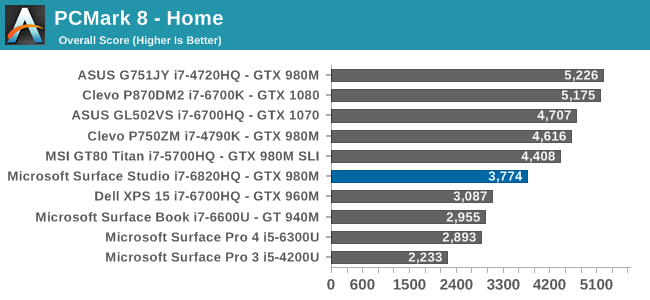

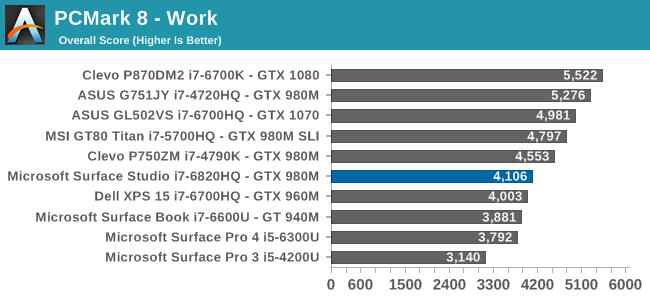
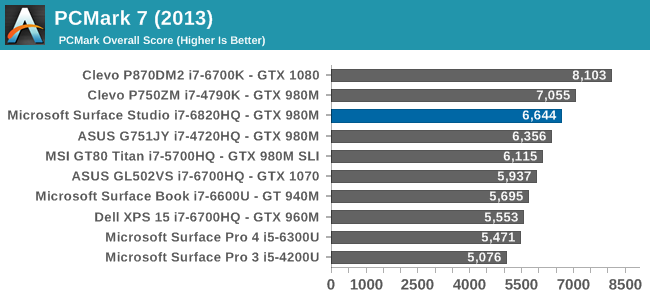
PCMark is a comprehensive set of tests, which uses real-world applications to test system responsiveness and performance. All aspects of the system are tested, including the storage, and even display resolution can have an affect. Here the Surface Studio is decidedly average, with decent scores in some tests, but less than amazing results in others. The hybrid storage and high display resolution likely didn’t help out the Surface Studio here.
Cinebench
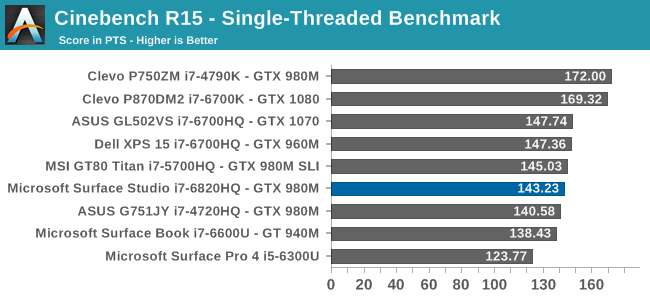
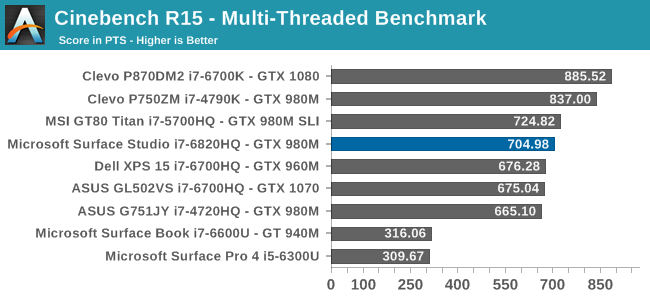
Cinebench is a purely CPU test, and despite the Surface Studio having a Core i7-6820HQ when most quad-core laptops are the i7-6700HQ, it still fell slightly below them on this test.
X264
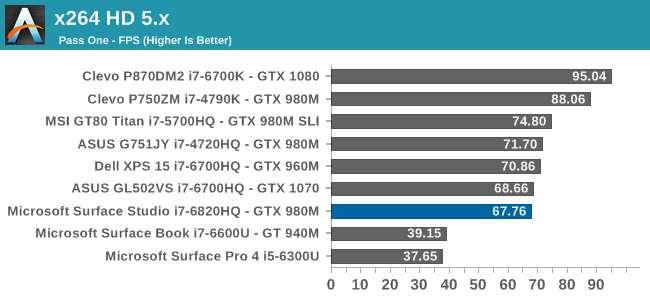
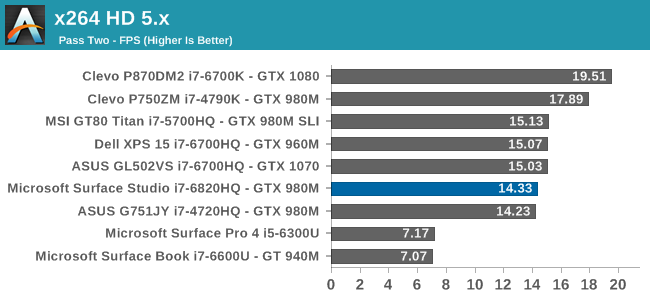
Much like Cinebench, this is a pure CPU test, but unlike Cinebench which renders an image, x264 encodes a video file. As with Cinebench, the Surface Studio falls a bit under the performance of the i7-6700HQ found in most notebooks.
Web Tests
Browsing the web is likely what most computers do, most of the time, but unlike the previous tests, web tests are always evolving over time as the underlying browsers are updated. For our tests, we use the latest version of Microsoft Edge.
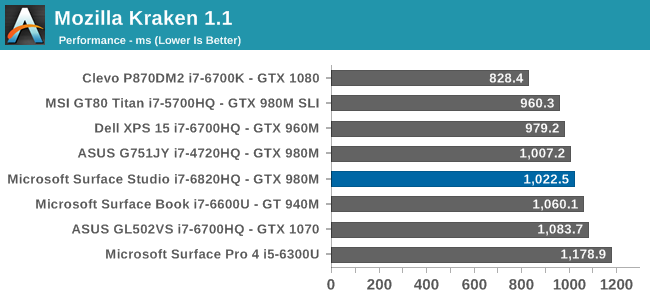
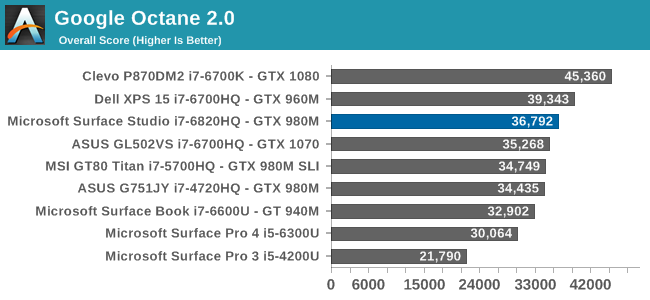

As with the other tests, the Surface Studio falls just a hair under the performance of typical quad-core laptops. With a sample size of one, it’s difficult to point the finger at why this is – is it cooling or is it something else – but I would have expected it to be just slightly ahead of the i7-6700HQ machines.










197 Comments
View All Comments
jlabelle2 - Friday, January 27, 2017 - link
- Unique doesn't automatically mean "better." I realize you want to defend this for psychological rather than practical reasons and that's completely okay.Correct (1st sentence) and wrong (2nd sentence).
And this is why I make a difference between the fixed trackpad and home button of the iPhone / Mac that serve absolutely no purpose compared to the SB hinge that have a clear functionality of pushing the screen further away of the base when open (to counteract its weight).
On top of that, it helps avoiding marking of the key on the screen but it is not its primary function.
Those have been explained to y ou but you still dismiss those and I don't know why even if you try to put some psychology into that whereas it is basic proven fact.
sorten - Friday, January 20, 2017 - link
Apple only has 5% of the PC market, and yet we still take them seriously. Right? The Surface line has been very successful and very profitable for Microsoft. The Surface line has also brought innovation and excitement back into the PC market.hlovatt - Sunday, January 22, 2017 - link
Apple sells about 5 million macs per quarter and Microsoft sells about 1 million surface branded computers per quarter. Therefore Apple is significantly bigger than Microsoft in sales, the difference is even more in terms of revenue.However, despite the low sales of surface I am glad that Anandtech covers the surface range since they are innovative. I would also like to see more Apple coverage, likewise because it is innovative.
In general, I am keen on reviews of niche products and I am bored by reviews of mainstream except for providing a benchmark to judge the innovative products against.
fanofanand - Monday, January 23, 2017 - link
What exactly has Apple innovated in the last ten years?hlovatt - Monday, January 23, 2017 - link
Gee let me think for a second: iPhone, iPad, retina displays, gloss displays, uni-bodied products, all day battery life for laptops, touch pads on desktops, iMac style all-in-ones (which the studio owes a great deal to), ...Got bored if thinking of things, who do you suggest has done more?
fanofanand - Tuesday, January 24, 2017 - link
So Apple's innovation is taking someone else's idea and improving on it? And that impresses you? They didn't invent the smart phone, they didn't invent the tablet design or form-factor, retina is a marketing term, not anything "real". Glossy displays reflect light more and are difficult to see in several situations, they weren't the first to do an all-in-one, and what on earth do you mean by "touch pads on desktops"?Sorry but your list is weak, and is nothing but Apple taking other's ideas and running with it. Apple's only true "innovation" is making things pretty, and simple enough for tech illiterate folks to use them.
simonm - Tuesday, January 24, 2017 - link
And adding to hlovatt's list:Mostly solid-state trackpads with very realistic click sensation, MagSafe (RIP), best fingerprint reader, Thunderbolt, pressure sensitive phone screens. Lightning connector, which despite being propriotory is actually very good (I've had numerous micro USB cables break on me). Ultra-slim laptops. Plenty of software tech underpinning OS X (I refuse to call it macOS for a few years). Pushing to have sRGB phased out. Pushing adoption of USB-C (and collaborating on the spec).
The company may be greedy and risking their competitiveness but they have some good innovative tech that keeps them in the business. To say Apple isn't innovative is kind of a troll-worthy comment.
fanofanand - Tuesday, January 24, 2017 - link
TB was designed and invented by Intel, not Apple. solid-state trackpads? You realize they don't build those right? Pressure sensitive phone screens have been around for years. Best fingerprint reader is an opinion not a fact that can be validated. Ultra slim laptops are the bane of actual computing, they take dramatically reduced internals and jack up the price because "thin". "pushing adoption of USB-C" so now that's an innovation? I think your love of Apple has blinded you to the truth. Seriously, you said "with a very realistic click sensation" wtf does that even mean? Who decides what a "realistic click sensation" is? Pathetic fanboys.jlabelle2 - Thursday, January 26, 2017 - link
Yes Apple has realized really some innovation, but as Samsung or LG or Microsoft or others.But they have also push a lot of standard things with marketing terms to try to appropriate themselves a perception of innovation (high resolution screen, Thunderbolt, all-in-one..) or try to make "different" without advantages and tried to push that as innovative: glossy screen (often necessary with touchscreen tech but avoidable for non touch screen Mac), fix simulated trackpad (which is a complete non sense as the gain of place with the motor unexistant and worse than a real one), only USB-C ports, touch pad for desktop...
At last, they are very good at battery life but when it is at the expense of a TN low resolution non-touch screen like the iPad Air, it is just a different set of compromise than others.
And the lightning cables of Apple are abn absolute chores. They last 2-4 months in average and I must have had more than 10 cables failing as regularly as a clock. This is not per see a problem of the Lightning port but the construction but still...
osxandwindows - Wednesday, February 1, 2017 - link
Apple pay, the first real mobile payments solution, airpods, it changed the wireless headphone market for the better, the smartwatch, little features with new updates and the new watch are innovative, little things that turn out to be really useful.